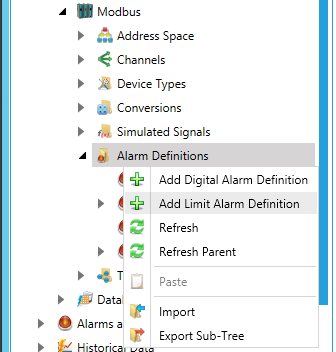|
|
The features on this page require an add-on to work with GENESIS64 Basic SCADA. |
|
|
The features on this page require an add-on to work with GENESIS64 Basic SCADA. |
To Create a New Limit Alarm Definition:
From the Project Explorer, click on Alarm Definitions, then New, then Limit Alarm Definition, as shown below.
New Limit Alarm Definition from the Project Explorer

-OR-
Select the Alarm Definitions node in the Project Explorer, then click on the Add Limit Alarm Definition button (shown below) in the Edit section of the Home ribbon in the Workbench.
Add Limit Alarm Definition Button

This opens the New Limit Alarm Definition properties in the right side of the configurator, as shown below. Each Limit Alarm Definition has specific parameters, as shown below.
Limit Alarm Definition Properties

A limit alarm sets the values for four levels of alarms: HiHi, Hi, Lo, and LoLo. Limit alarm parameters can have subranges within the data item amplitude. Every subrange definition includes Message Text that will be appended to the alarm message, the Severity of the alarm, and the Req. Ack. flag for alarm acknowledgement.
In the Limit Alarm Definition Properties dialog box, shown above, configure the following settings:
In the Limit Alarm Definition Name field, type a name for the new limit alarm.
Update Rate defines the frequency of checking the data item value (in milliseconds), and possibly responding by sending the alarm message.
The Enable checkbox allows you to enable any individual alarm level (HiHi, Hi, Lo, LoLo).
The Value field is used to calculate the state of the input fields. For example, a value of 10 for LoLo is compared with the value of the input to determine if the alarm is in LoLo state.
In the Message Text field, enter the warning message that will appear when the alarm is sent. The message can be any text string.
Note: It is not necessary to enter a message text or a base text. The Server will default to the OPC subcondition name and the OPC condition name. For example, a LoLo alarm will post a description of LoLo limit.
Severity is the OPC-defined value for alarm Priority. The valid OPC severity range is 0 (lowest) to 1000 (highest).
The Req. Ack field is used for OPC condition alarms to determine whether the alarm needs a user acknowledgement. If the Req. Ack field is checked, then the alarm requires a user acknowledgement. If the value is not checked, then the alarm is posted as already acknowledged.
In the Return To Normal field, check the check box and then enter the text that will appear when the alarm is taken care of (e.g. has been acknowledged). The message can be any text string.
Note: Changes to the alarm property fields (HiHi, LoLo, Hi, Lo, Message Text, etc.) in runtime through an OPC tag update will be automatically saved to the database, over-writing any values specified in configuration mode.
Click Apply to save your changes and Close to return to the Workbench.
See Also: